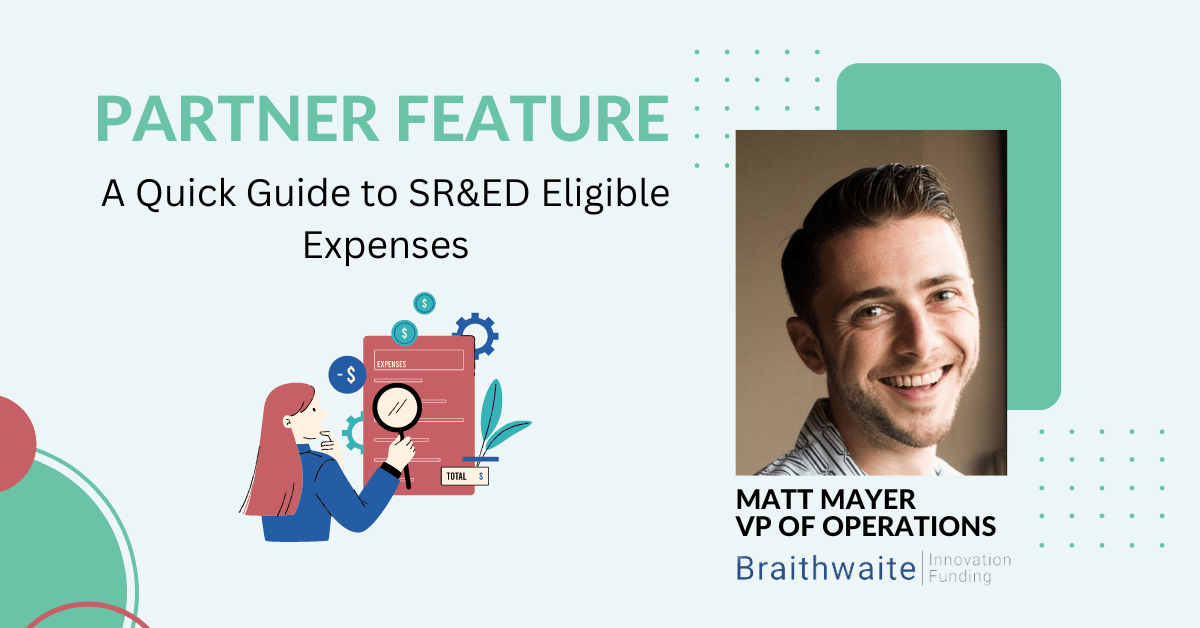Reading time: 5 minutes
If you’re a small or medium-sized business in Canada, government initiatives exist to support your growth and innovation. Whether it’s a new type of software or advanced manufacturing technology, one of the government’s goals is to help Canadian businesses take their ideas to market. This supports wealth creation and economic growth and helps make Canada a world leader in innovative new tech.
While both the Industrial Research Assistance Program (IRAP) and the Scientific Research & Experimental Development (SR&ED) tax credit can be used to fund your project, there are some differences between the two. IRAP, facilitated by the National Research Council of Canada, is a grant of up to $10M created to help companies begin developing their ideas more quickly than they may have been able to otherwise. The SR&ED program (run by the CRA) provides your business with investment tax credits to offset the cost of research and development you’ve already done.
Since both programs cover research, innovation, and development projects, some companies (mistakenly!) believe that they can’t be used at the same time. IRAP grants are awarded before you begin a project, with the funds being disbursed as you submit your eligible expenses to help you get it done quickly, and SR&ED tax credits are given afterwards to offset what you spend. Although the same dollar can’t be subsidized twice, the two programs can and should, be seen as complementary. Combining SR&ED and IRAP correctly can save you money and accelerate your R&D projects.
What is SR&ED?
The SR&ED program is an investment tax credit designed to encourage research and development work completed in Canada by Canadian companies. A refundable tax credit is offered to any Canadian-controlled private corporations (CCPC) for qualifying R&D expenditures up to $3M at a rate of 35%. Non-CCPCs, as well as the portion of CCPC claims above $3M, can claim a non-refundable credit of 15%.
Eligible work falls under basic research, applied research, and experimental development. This can include work relating to engineering, design, mathematical analysis, computer programming, data collection, and more.
How to Apply
Claiming SR&ED expenditures for an individual or a corporation involves filing an income tax return and completing Form T661. Form T661 provides the government with the technical information needed to calculate your qualifying R&D expenditures. Filing must be done within 18 months of the tax year-end, and CCPCs who file within 6 months can expect a response from the CRA within 2 months. Non-CCPC claims can take up to a year.
Before applying for a SR&ED tax credit, you’re eligible to file a pre-claim consultation request form. This lets you connect with a CRA representative who can give you advice on your application. A similar advisory service exists for first-time applicants. However, the best path to approval is through a SR&ED consultant. These experts understand both the technicalities of your project and the tax laws surrounding it, which dramatically improves your chances of approval.
What is IRAP?
The National Research Council of Canada’s IRAP is the leading program in Canada for helping small and medium-sized businesses get their ideas off the ground. Grants of up to $10,000,000 are available to help R&D in Canadian companies. Last year the IRAP program provided over $335M in grants to Canadian companies.
The program operates by funding research, growth, innovation, and development in order to help companies go from idea to market faster. Funds are disbursed over $335M was given out to Canadian companies last year in advance of the project’s initiation so that the organization can move more quickly from conception to development to eventual sale.
Eligible applicants are for-profit small and medium-sized enterprises (SMEs) that operate in Canada and have less than 500 full-time employees. These enterprises should be organizations looking to develop and commercialize innovative products, processes, or services that will ultimately generate revenue for the firm.
How to Apply
To apply for IRAP funding, applicants are required to undergo a consultation with a local Industry Technical Advisor (ITA). The advisor will ask you questions to evaluate aspects of your existing company, including the management team, your financial capabilities, the skills and assets of your employees and the technology you’re hoping to build. They’ll also take a look at how your idea fits into the existing market, your high-level plans for implementation, your timelines for building the project, and any pitfalls you could potentially face.
Once approved, you’ll get a template to submit your formal proposal. There are no deadlines to apply, but it’s best to submit as soon as possible. Once your project is approved (and funded), your ITA will continue to support you in getting your idea off the ground.
What are the Key Differences Between IRAP & SR&ED?
While IRAP and SR&ED programs both look at funding growth and innovation in Canadian companies, there are a few key differences:
- IRAP is a grant (the funds are disbursed as you submit your eligible expenses), and SR&ED is a tax credit (funds are given in the form of a refund.)
- Companies eligible for IRAP grants are selected by the federal government, while SR&ED credits are the right of every taxpayer.
- Once your IRAP project is approved, you will receive disbursements either monthly or quarterly against your eligible claimed project expenses.
- SR&ED tax credits are accrued over the tax year while your R&D work is already in progress. Upon filling form T661 at the end of that tax year, the CRA will review and adjudicate the eligibility of those expenses.
Can You Use Both Programs Concurrently?
Yes! IRAP financing and SR&ED tax credits aren’t mutually exclusive. Companies looking to fund their innovative ideas should start with IRAP and use SR&ED credits for any eligible expenses that remain. In successful IRAP applications, associated expenses are paid out monthly based on the budget outlined with your advisor. This is crucial for your company’s cash flows since it gives you the money to fund your R&D ahead of time and frees up the rest of your capital for growth.
Typically a company should first claim their eligible expenses towards its IRAP grant, and then claim the eligible balance under SR&ED. For example, an engineer with $100k salary may qualify for $20k under the company’s IRAP grant. This leaves $80k that a business can claim under the SR&ED program. So the order of operations is to first apply the IRAP grant to the salary and then claim for SR&ED for the remainder of their SR&ED-eligible salary.
Being eligible for (and receiving) IRAP grants provides you with funds upfront, while SR&ED credits can cover some of the excess expenses associated with your project. However, there are ways to make getting access to the money from IRAP and SR&ED programs even easier.
Financing IRAP & SR&ED
Instead of waiting months for the CRA to disburse your funds, SR&ED or IRAP financing can give you access to this capital immediately. Lenders (like Venbridge) will consult with your organization to recommend grants, subsidies, or loans your business may qualify for. Incoming funds (such as for a grant your company has applied for but not yet received), subsidies or tax credits can then be used to secure a loan.
SR&ED financing is limited to the amount of refundable SR&ED tax credits for which you’ve qualified. This is limited to how many of your R&D expenses are SR&ED eligible. If you haven’t spent much on R&D this year, the amount you can finance will be reflected in that number.
However, grant amounts can be much higher than SR&ED eligible expenses. Grant amounts are typically decided based on how big of an impact the company’s proposed development will have on the grant provider’s objectives. If you have a large project approved by IRAP and grants on the way, you can be approved for a larger loan.
IRAP grants and SR&ED tax credits are one of the government’s ways of supporting the innovative ideas of Canadian businesses. Getting access to that capital ahead of time is a valuable way to speed up getting your product to market and help your company grow faster. Whether it’s funding critical new hires, launching into new markets, upping sales and marketing, or accelerating development prior to an equity raise, SR&ED and IRAP financing can help you take your business to the next level.




